The term “Krishnam Vande Jagadgurum” is widely renowned phrasing and a common fixture in many religious discourses in Hinduism. It originates from the Sri Krishnastakam, a beautifully profound ashtakam (eight-verse hymn) dedicated to the praise and worship of Lord Krishna.
This phrase, not unlike the rest of this hymn focuses on the universal truths that Krishna represents. Things such as the importance of duty without attachment to outcomes, the value of righteousness, and the power of devotion, among other things.
It then touches on Krishna’s innumerable divine acts, his magnetic personality, and cosmic beauty, with each and every verse painting a vivid picture of the Lord, invoking a sense of bhakti (Devotion) and admiration.
Each verse closes on a high note “Krishnam Vande Jagadgurum”, hailing Lord Krishna as the “Jagadgurum” or the universal teacher. Far from a mere title, this term signifies Krishna’s role as a guide, not just for the devout or the seekers, but for individuals from all walks of life, and all over the world.
Meaning of Krishnam Vande Jagadgurum
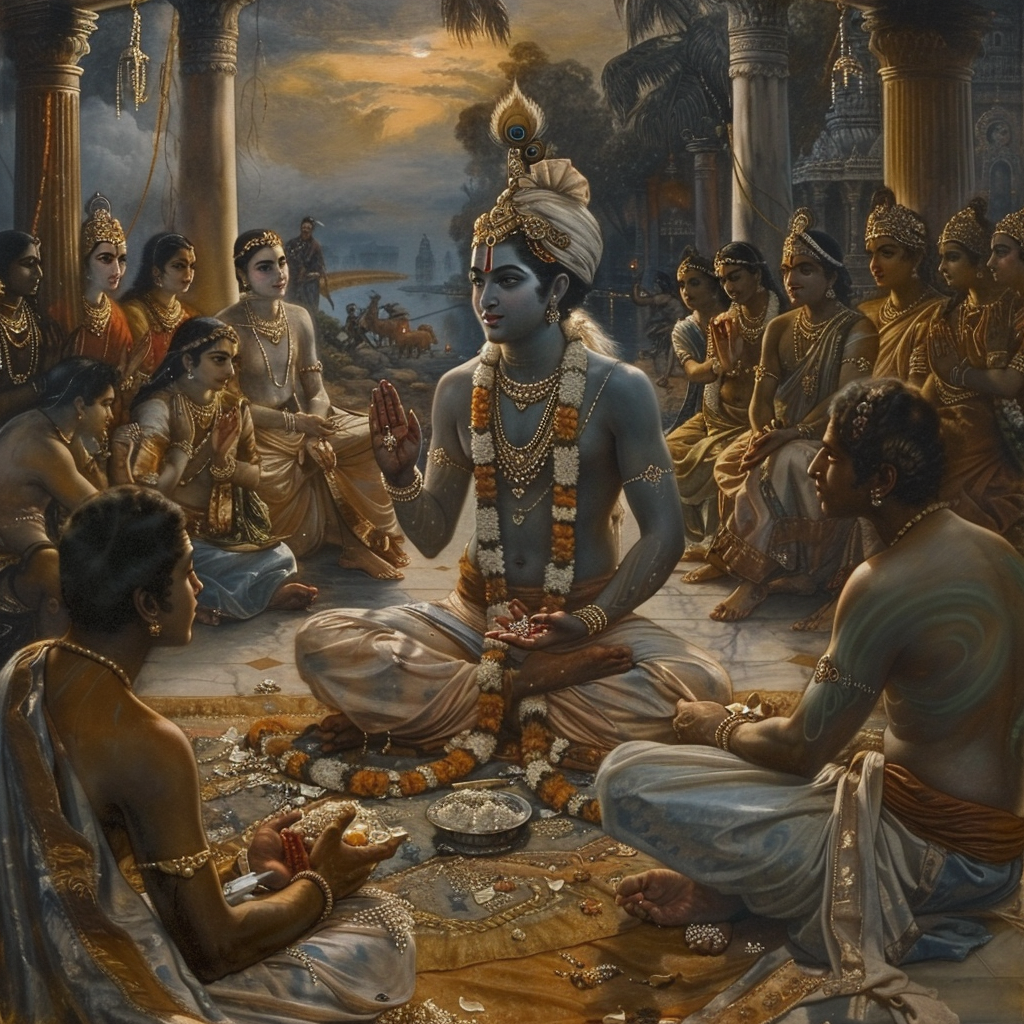
Krishnam: Refers to Lord Krishna, who is not just a deity in Hinduism but also a symbol of wisdom, love, and dharma (righteousness). The Lord gave the Bhagavad Gita, clarifying the meaning of dharma and the purpose of life once and for all.
Vande: this means “I praise” or “I salute.” It’s a way of showing deep respect and adoration. Thanking the Lord for all that he has done for the universe, and expressing our heartfelt admiration for the same.
Jagadgurum: This is a combination of two words, “Jagat” (universe) and “Gurum” (teacher or guru).
So, when you put it all together, “Jagadgurum” is calling Krishna the teacher of the entire universe. The title is bestowed on the Lord given the remarkable impact of scriptures such as the Bhagavad Gita have had on human society.
This acknowledgment is not just of his divine wisdom but also of his role as the guide and mentor to all beings, leading them from the darkness of ignorance to the light of wisdom and liberation.
Let’s dive into a casual walkthrough of its essence, keeping it light and digestible.
Krishnashtakam – Krishnam Vande Jagadgurum Lyrics With Meaning
Vasudeva Sutam Devam
Kamsa Chaanoora Mardhanam |
Devaki Paramaanandam
Krishnam Vande Jagadgurum ||
Vasudeva Sutam Devam: Here Lord Krishna is introduced as the divine son of Vasudeva. “Vasudeva Sutam” means “the son of Vasudeva” pointing to his royal lineage and divine origin. The word “Devam” emphasizes his divinity, since he is not just a prince but a God among humans.
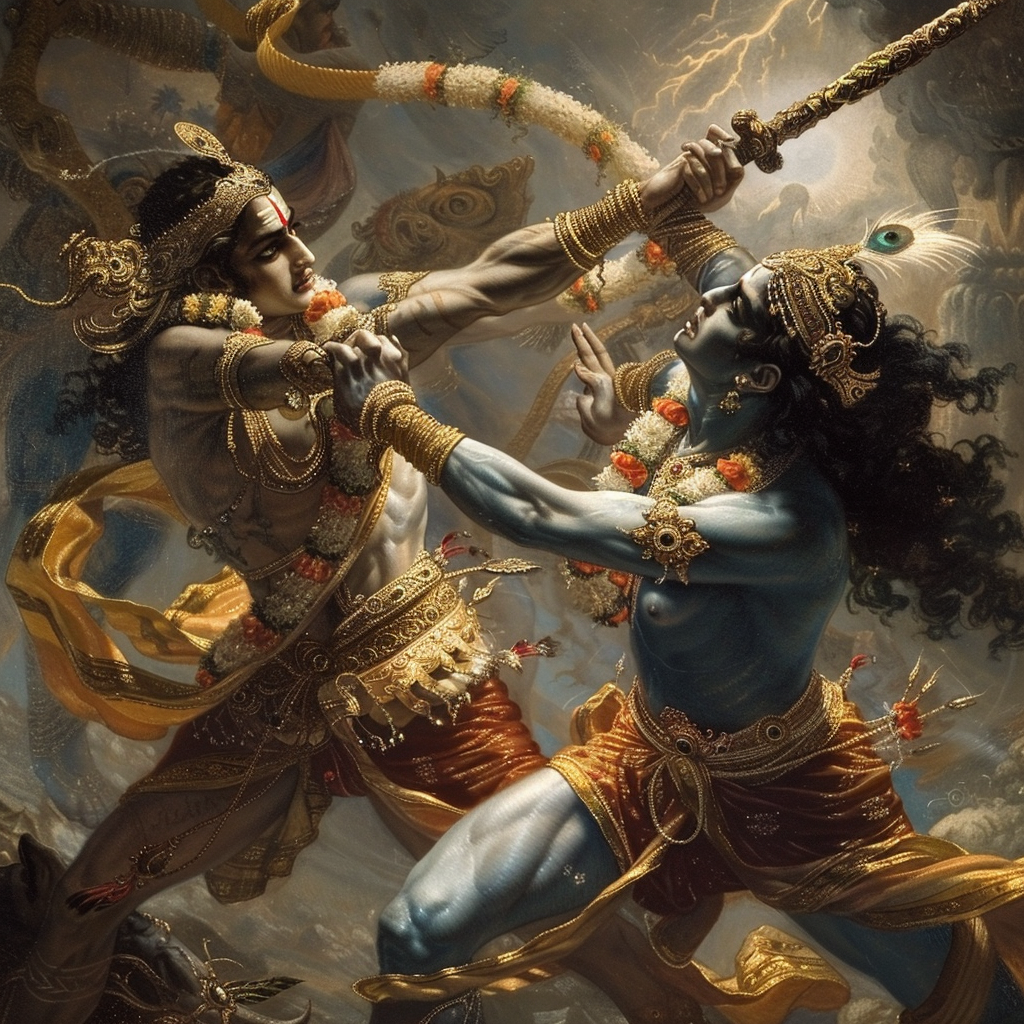
Kamsa Chaanoora Mardhanam: This phrase refers to Krishna as the annihilator of Kamsa and Chanura. In the battle against Kamsa and Chanura, Krishna embodies the universal principle of good prevailing over evil.
This narrative encourages the belief in the ultimate victory of light over darkness, a theme that resonates deeply within the human psyche. It reassures us that no matter how daunting the forces of negativity may seem, they are ultimately transient against the immutable power of truth and righteousness.
Devaki Paramaanandam: The joy that Krishna brings to Devaki, his mother. “Paramaanandam” translates to supreme joy or bliss.
Despite the trials Devaki faced, Krishna’s presence brought her immeasurable happiness, emphasizing the deep bond between divine child and devoted mother.
Atasee Pushpa Sankaasham
Haara Noopura Shobhitam |
Rathna Kangana Keyooram
Krishnam Vande Jagadgurum ||
Atasee Pushpa Sankaasham: Here, Krishna is described as having the complexion of the Atasee flower, which is a deep, rich blue, almost like a mesmerizing blend of the twilight sky. This comparison is not just about physical beauty but also symbolizes his depth, his infinity, and his encompassing presence, much like the vast sky.
Haara Noopura Shobhitam: Lord Krishna is adorned with a garland (Haara) and anklets (Noopura) that radiate splendor (Shobhitam). The garland and anklets are traditional symbols of divine beauty and grace.
Their sounds and appearances not only add to his divine aura but also signify the joy and festivity that follows Krishna wherever he goes.
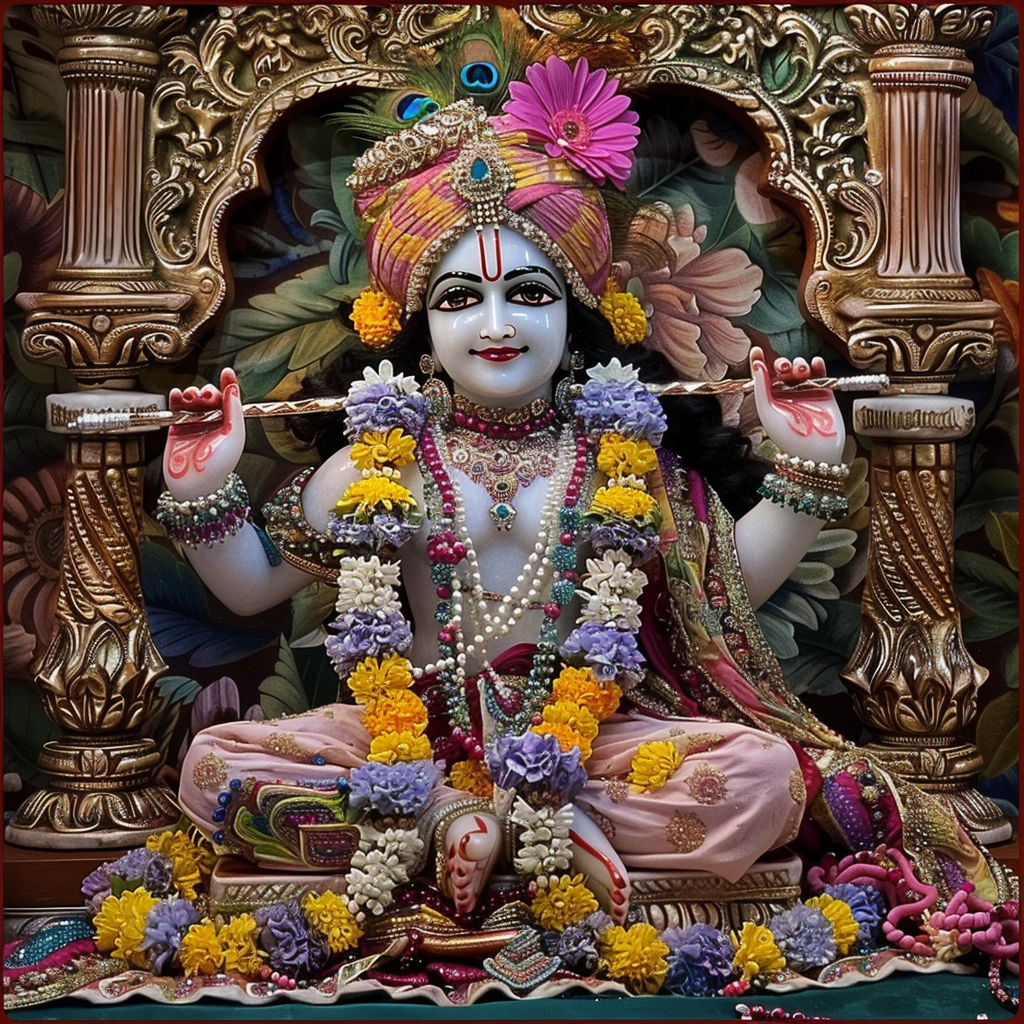
Rathna Kangana Keyooram: Here, we see Krishna adorned with armlets (Kangana) and bracelets (Keyooram), studded with precious gems (Rathna).
Far from being just about opulence, this imagery hints at the richness of spiritual wealth and the beauty of virtues that the Lord embodies. Each gem signifies different values and qualities, such as compassion, wisdom, strength, and love.
In essence, this verse does more than describe Krishna’s physical appearance, it captures his essence as the embodiment of divine beauty, joy, and spiritual wealth.
Through this vivid imagery, the devotee expresses admiration not only for Krishna’s external beauty but also for his inner radiance that lights up the universe. It’s a celebration of Krishna’s presence, which brings beauty, joy, and guidance to the world.
Kutilaalaka Samyuktam
Poorna Chandra Nibhaananam |
Vilasat Kundala Taram
Krishnam Vande Jagadgurum ||
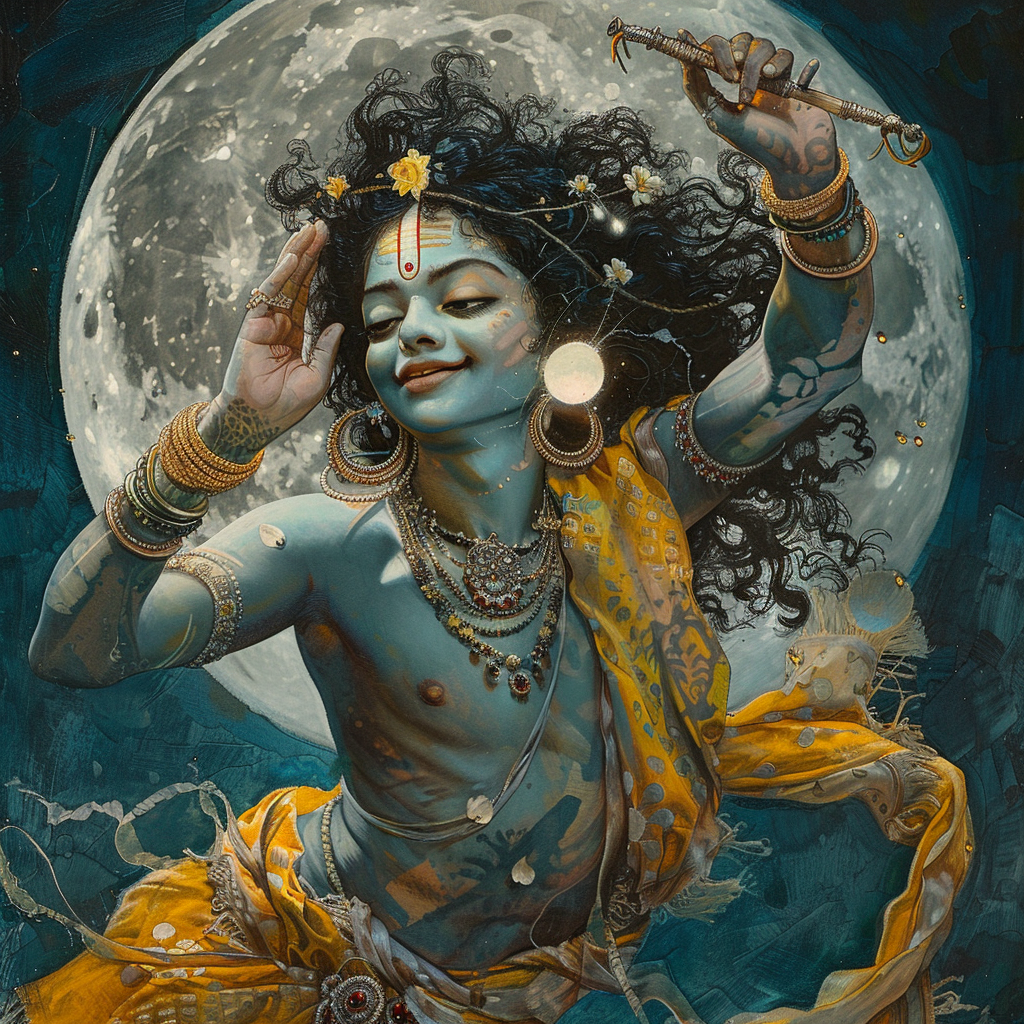
Kutilaalaka Samyuktam: The verse begins by drawing attention to Krishna’s locks of hair, described as ‘Kutila’ or curly.
The imagery of his curly, flowing hair isn’t just about physical appearance, but it rather suggests a sense of freedom and the enchanting, almost mesmerizing beauty that draws devotees and onlookers in.
The way his hair frames his face and dances around his cheeks adds to the divine allure that Krishna is known for.
Poorna Chandra Nibhaananam: Lord Krishna’s face is compared to a full moon (Poorna Chandra), radiating peace, calm, and a soothing, gentle light. This simile is rich in meaning, suggesting not just physical beauty but the luminous, calming presence that Krishna embodies.
The full moon is a universal symbol of serenity, completeness, and the dispeller of darkness, much like Krishna’s presence which brings light and joy to the lives of his devotees.
Vilasat Kundala Taram: The focus then shifts to Krishna’s earrings (Kundala) which are described as dazzling or gleaming (Vilasat). The earrings swinging and reflecting light as he moves symbolize the dynamic nature of the universe and the constant play of light and shadow.
The adornment of these earrings adds to his divine charm, suggesting not just wealth or status but the ability to hear the prayers and cries of his devotees, offering them comfort and guidance.
Krishnam Vande Jagadgurum: The verse concludes with a heartfelt veneration of Krishna, acknowledging him as the ‘Jagadgurum’ or the teacher of the universe.
This line ties back the descriptions of his beauty and divine attributes to his role as a spiritual guide and mentor, whose teachings and presence illuminate the path for countless souls across the cosmos.
This verse, in its entirety, is a beautiful amalgamation of physical descriptions and symbolic meanings, illustrating Krishna’s divine beauty and his comforting, guiding presence in the universe.
Through this evocative imagery, the devotee expresses deep reverence and admiration for Krishna, seeing him as the ultimate guide and protector whose divine play (Leela) enriches the universe.
Mandaara Gandha Samyuktam
Chaaruhaasam Chaturbhujam |
Barhipinchhaava Choodaangam
Krishnam Vande Jagatgurum ||
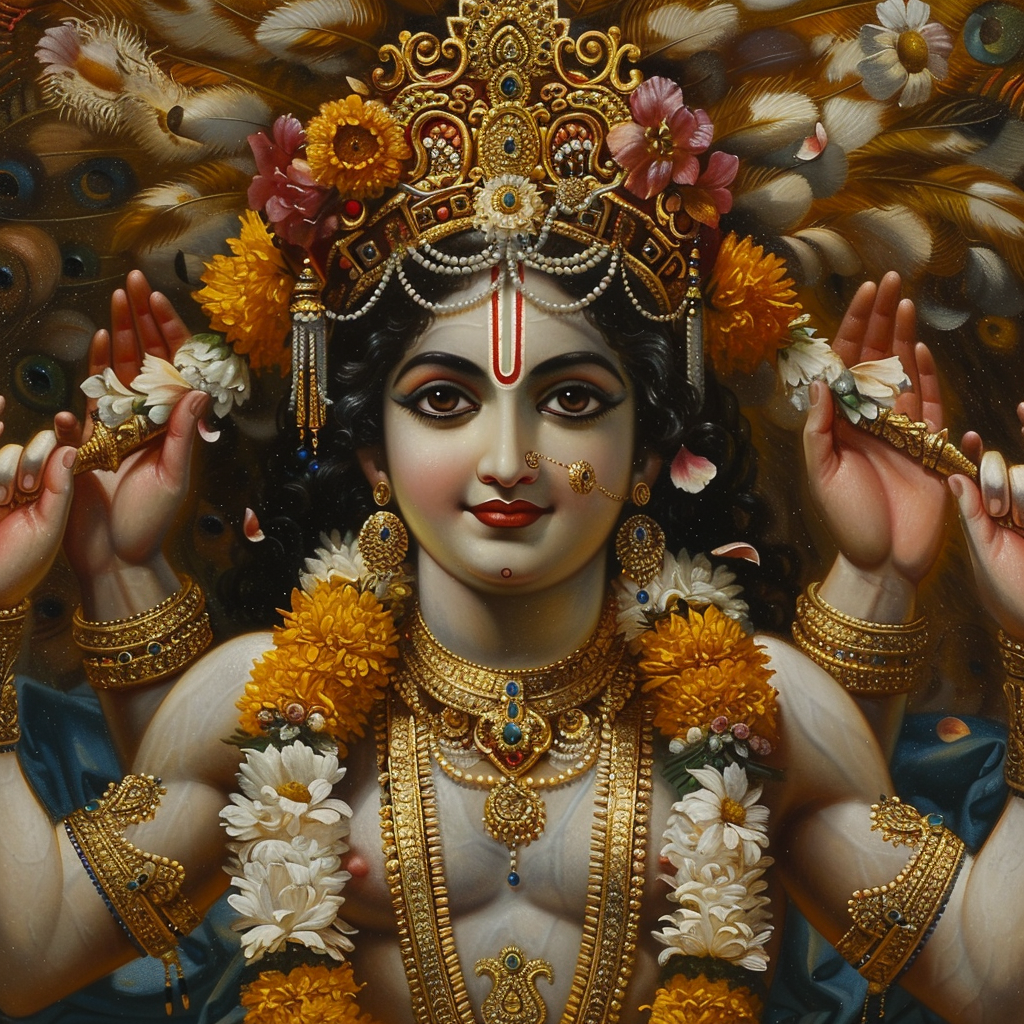
Mandaara Gandha Samyuktam: This verse starts off by describing Lord Krishna as being accompanied by the fragrance of Mandaara flowers. The Mandaara, a celestial flower known for its divine fragrance, symbolizes purity and sanctity.
The association of Krishna with this aroma suggests his divine purity and the blissful aura that surrounds him, indicating that his presence is as refreshing and elevating as the scent of heavenly blossoms.
Chaaruhaasam Chaturbhujam: Krishna is depicted here with a charming smile (Chaaruhaasam) and four arms (Chaturbhujam). The smile of Krishna is often described as bewitching and soothing, capable of dispelling the woes of the world.
The four arms represent his omnipotence and his ability to provide for the needs of his devotees in the material as well as the spiritual worlds. This imagery is rich in symbolism, portraying Krishna as both approachable and majestic, blending human-like qualities with divine attributes.
Barhipinchhaava Choodaangam: This phrase vividly pictures Krishna with a peacock feather adorning his head (Barhipinchhaava Choodaangam). The peacock feather, often seen in depictions of Krishna, is emblematic of beauty, grace, and the vibrant joy of life.
It also symbolizes the entire cosmos, with its myriad of colors and circular shape representing the cyclical nature of the universe. Krishna wearing it signifies his connection with the natural world and his mastery over the cosmic cycle.
In essence, this verse celebrates the divine presence of Lord Krishna, highlighting aspects of his personality and appearance that make him a source of joy, guidance, and protection for the devotee.
Through these detailed descriptions, the verse invites the reader to visualize Krishna’s enchanting form, drawing them closer to his divine essence and teachings.
Utphulla Padma Patraaksham
Neelajimuta Sannibham |
Yaadavaanaam Shiroratnam
Krishnam Vande Jagadgurum ||
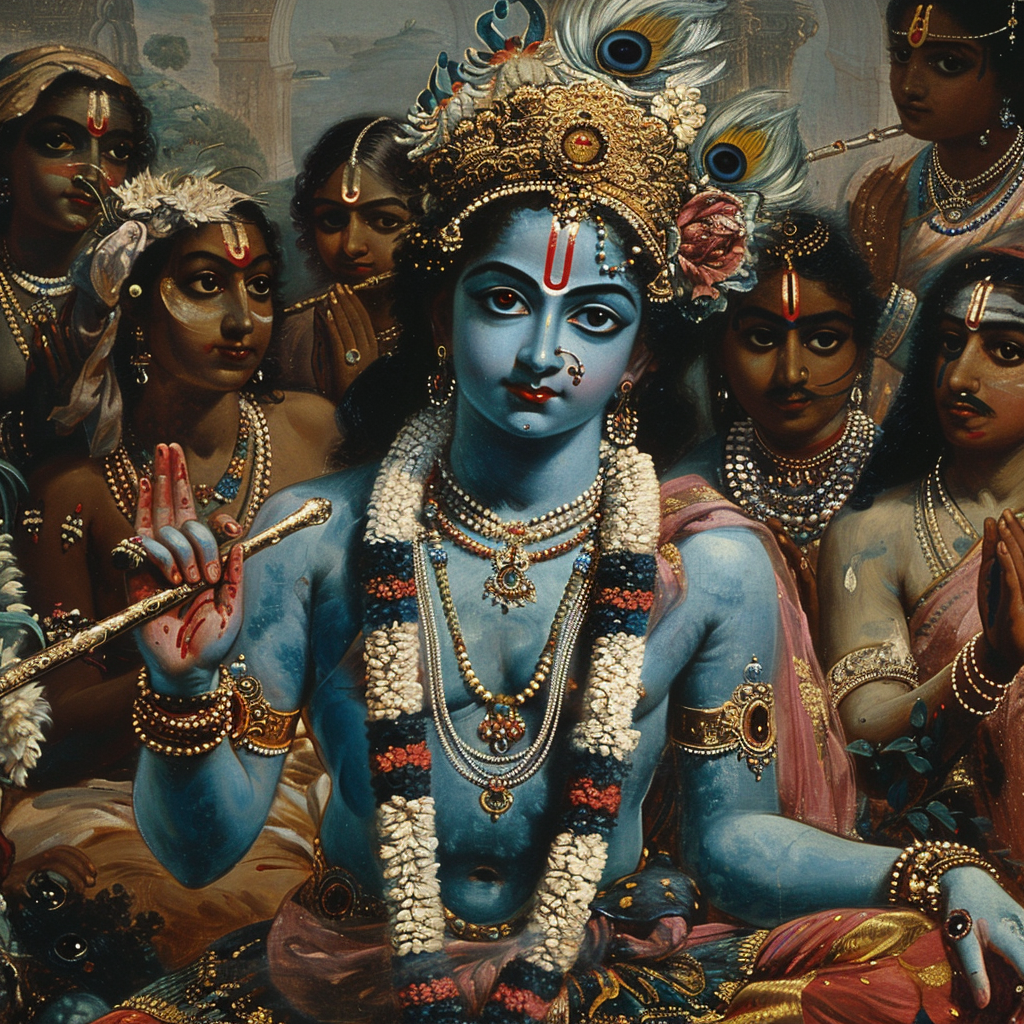
This verse from the Krishnashtakam is steeped in rich imagery, highlighting Lord Krishna’s divine attributes and esteemed position among the Yadavas. Let’s delve into its profound meaning:
Utphulla Padma Patraaksham: The verse begins by describing Krishna’s eyes as being like fully bloomed lotus petals (Utphulla Padma Patra).
This comparison is laden with symbolism, the lotus is often associated with beauty, purity, and spiritual enlightenment. It blooms in muddy waters, yet remains untouched and unstained, just as Krishna’s divine vision transcends the material realm, offering purity and guidance.
Neelajimuta Sannibham: Here, Krishna’s complexion is likened to a rain-bearing cloud (Neelajimuta), deep blue in color. This simile not only captures the mesmerizing beauty of Krishna but also symbolizes his association with life-giving water, fertility, and abundance.
Just as clouds nourish the earth with rain, Krishna’s presence nourishes the souls of his devotees, filling them with spiritual richness and emotional depth.
Yaadavaanaam Shiroratnam: The verse then honors Krishna as the crown jewel (Shiroratnam) of the Yadava clan (Yaadavaanaam). This phrase acknowledges Krishna’s leadership and his paramount importance among the Yadavas, a significant community in the Mahabharata.
As a ‘Shiroratnam’, Krishna is recognized not just for his royal lineage but for his exemplary qualities, wisdom, and the guiding light he provides to his people and devotees alike.
Krishnam Vande Jagatgurum: The verse culminates in a reverential salutation to Krishna, acknowledging him as the ‘Jagadgurum’ or the teacher of the universe.
This title reaffirms Krishna’s supreme role as a spiritual guide and mentor, whose teachings and divine play (Leela) transcend cultural and geographical boundaries, guiding countless souls toward enlightenment and liberation.
In essence, this verse encapsulates the divine and majestic aura of Lord Krishna, portraying him as a figure of supreme beauty, wisdom, and leadership.
Through the vivid imagery of his eyes and complexion, and by celebrating his paramount status among the Yadavas, the verse invites devotees to venerate Krishna as the ultimate guru, whose guidance lights the path to spiritual fulfillment and eternal bliss.
Rukmini Keli Samyuktam,
Peetambara Sushobhitam |
Avaapta Tulasi Gandham,
Krishnam Vande Jagatgurum ||
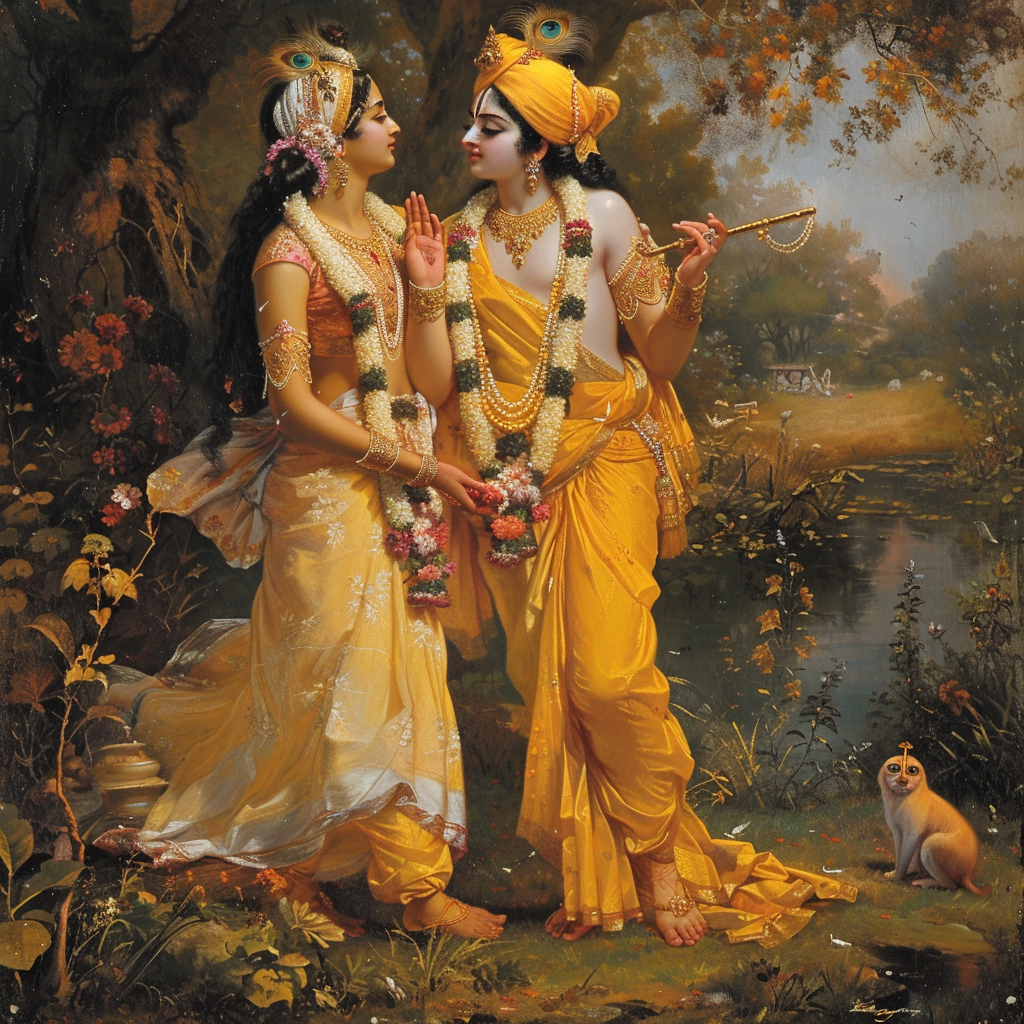
Rukmini Keli Samyuktam: This segment of the verse focuses on Krishna’s divine playfulness (‘Keli’) with Rukmini, his principal consort and a manifestation of the Goddess Lakshmi.
The reference to Rukmini not only highlights the loving and sacred bond they share but also symbolizes the divine union of supreme consciousness (Krishna) with nature and fortune (Rukmini).
This aspect of Krishna’s life illustrates the balance and harmony between divine energies, embodying ideals of devotion, love, and the sanctity of marital bonds in spiritual pursuits.
Peetambara Sushobhitam: Here, Lord Krishna is described as being adorned in ‘Peetambara’, a bright yellow garment, which greatly enhances his divine splendor (Sushobhitam).
Yellow, or golden, is often associated with knowledge, purity, and prosperity. This description not only paints a picture of Krishna’s majestic appearance but also symbolizes his embodiment of wisdom, wealth, and purity, illuminating the path for his devotees.
Avaapta Tulasi Gandham: This phrase captures the fragrance of Tulasi (holy basil) that Krishna has attained (Avaapta). Tulasi holds a place of immense sacredness in Hinduism, symbolizing purity, devotion, and the divine itself.
The mention of Tulasi’s fragrance suggests a presence so pure and sanctified that it attracts the divine.
It signifies the deep devotion and the sanctity of the relationship between the devotee and the divine, with Krishna being the central figure who sanctifies and elevates those around him through his divine presence.
Each element of this verse—the divine companionship with Rukmini, the vibrant yellow attire, and the sanctified fragrance of Tulasi—converges to portray Krishna as a figure of divine majesty, profound love, and spiritual purity.
Through this imagery, devotees are reminded of Krishna’s encompassing and uplifting presence, guiding the soul towards divine love, wisdom, and ultimate liberation.
Gopikaanaam Kuchaadvandva
Kunkumaankita Vakshasam |
Shriniketham Maheshvaasam
Krishnam Vande Jagadgurum ||
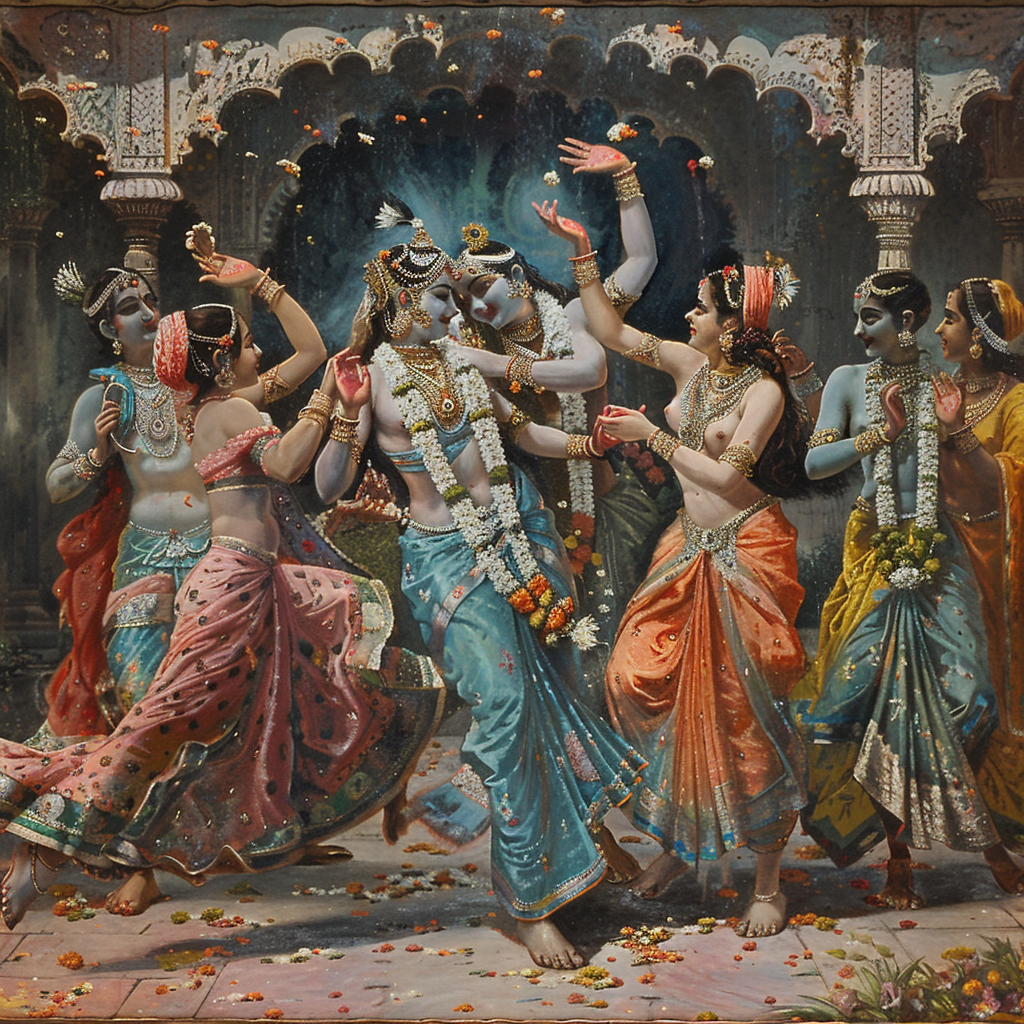
This verse from the Krishnashtakam delves deeper into the divine and alluring aspects of Lord Krishna, highlighting his intimate interactions with the Gopikas (milkmaids) and his supreme status. Let’s unpack the profound symbolism and imagery:
Gopikaanaam Kuchaadvandva Kunkumaankita Vakshasam: This phrase vividly describes Lord Krishna’s chest, marked with the red kumkum powder from the breasts of the Gopikas. The Gopikas, often symbolizing devoted souls, find their ultimate refuge and expression of love in Krishna.
The kumkum marks signify the intimate and loving exchanges between Krishna and his devotees, representing the deep and personal relationship that the divine is capable of sharing with the devotees.
Shriniketham Maheshvaasam: ‘Shriniketham’ refers to Krishna being the abode of fortune and beauty, a place where Lakshmi, the goddess of wealth and prosperity, resides. It points out Krishna’s divine magnificence and the idea that all spiritual and worldly fortunes find their ultimate source in him.
‘Maheshvaasam’ denotes Krishna’s role as the wielder of the great bow, symbolizing his prowess and readiness to protect righteousness and his devotees from the forces of evil and ignorance. This duality of soft, loving grace and warrior-like strength captures the essence of Krishna’s divine play (Leela).
Through this verse, the Krishnashtakam not only celebrates the divine beauty and allure of Lord Krishna but also his profound and intimate connection with his devotees, his embodiment of both tenderness and strength, and his universal guidance.
It’s a rich tapestry of devotion, symbolizing the multifaceted relationship between the divine and the devout, where divine love is both personal and expansive, embracing all aspects of the human and spiritual experience.
Shrivatsaankam, Mahoraskam,
Vanamaala Viraajitam |
Shankha-Chakra-Dharam Devam,
Krishnam Vande Jagadgurum ||
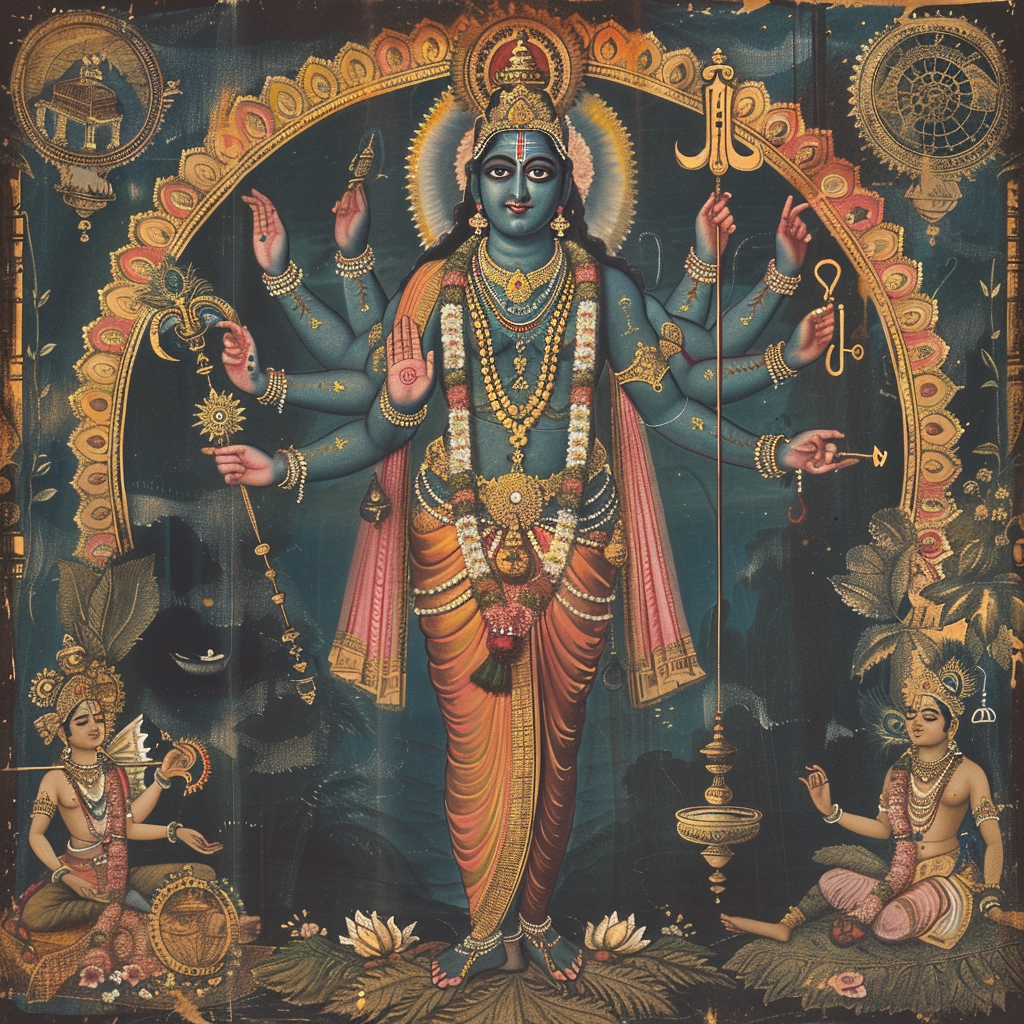
Shrivatsaankam: This phrase refers to the mark of Shrivatsa, a special symbol on Lord Krishna’s chest, often associated with a curl of hair or a mark indicating the presence of the goddess of fortune, Lakshmi.
It symbolizes Krishna’s eternal connection with divine prosperity and his role as a harbinger of wealth and well-being for his devotees. The Shrivatsa is a mark of divine auspiciousness, signifying Krishna’s benevolence.
Mahoraskam: The term ‘Mahoraskam’ describes Krishna as having a broad and majestic chest, symbolizing his immense strength and capacity to encompass all of creation within his heart. It is a poetic way of acknowledging Krishna’s infinite love and protection for all beings, a shelter where devotees find refuge.
Vanamaala Viraajitam: This line illustrates Krishna adorned with a ‘Vanamaala’—a garland made of wildflowers from the forest. This garland is not just a decorative item but represents the beauty of the natural world and Krishna’s deep connection with all of creation.
It symbolizes the universality of life and Krishna’s love that extends to every part of the universe, embracing both the grandeur and the simplicity of the natural world.
Shankha-Chakra-Dharam Devam: Krishna is depicted here as holding the conch (Shankha) and discus (Chakra), two of his most famous symbols.
The conch represents the primordial sound of creation and divine communication, whereas the discus symbolizes the mind’s infinite capacity for discernment and the destruction of ego and ignorance.
Krishna bearing these is a reminder of his role as the sustainer and protector of the universe, guiding the cosmic order and offering wisdom and protection to his devotees.
This verse, through its vivid imagery and symbolism, encapsulates the divine essence of Lord Krishna, portraying him as a figure of boundless love, universal wisdom, and the epitome of cosmic harmony.
It invites devotees to reflect on his divine qualities and seek solace and guidance in his eternal teachings.
Benefits of Chanting Krishnashtakam – “Krishnam Vande Jagadgurum“
Krishnaashtakam Idam Punyam
Praata Ruththaaya Yaha Padeth |
Koti Janma Krutam Paapam
Smaranena Vinashyati ||
This concluding verse of the Krishnashtakam offers a promise of spiritual redemption and immense merit to those who engage with this sacred hymn. It beautifully encapsulates the transformative power of devotion and the recitation of this ashtakam (eight-verse hymn). Let’s break down its profound meaning:
Krishnaashtakam Idam Punyam: The verse begins by declaring the Krishnashtakam itself as ‘Punyam,’ meaning meritorious or sacred.
The term points out the spiritual value and sanctity of these Krishnam Vande Jagadgurum lyrics dedicated to Lord Krishna, suggesting that the hymn is not just a collection of praises but a significant spiritual practice that carries immense positive karma.
Praata Ruththaaya Yaha Padeth: This line advises that the one who recites (Padeth) the Krishnashtakam upon rising at dawn (Praata Ruththaaya) will be the beneficiary of its blessings. The mention of morning emphasizes the importance of starting the day with spiritual reflection and devotion, setting a tone of sanctity and mindfulness for the activities that follow.
Koti Janma Krutam Paapam Smaranena Vinashyati: Here, it is said that even the sins accumulated over ‘Koti Janma’—ten million births are destroyed (Vinashyati) by the mere remembrance (Smaranena) of the Krishnashtakam.
This highlights the concept in Hindu philosophy that the remembrance of the divine, and the recitation of sacred texts dedicated to them, can lead to liberation from the cycle of birth and death, guiding the soul toward moksha (liberation).
At its core, this verse promises spiritual elevation and liberation from karmic cycles to those who devoutly recite or remember Krishnam Vande Jagadgurum lyrics in Krishnashtakam.
It’s a testament to the power of bhakti (devotion) and the sacred act of engaging with divine praises as a means to purify the heart and soul, thereby drawing closer to the divine essence of Lord Krishna.
This promise encourages devotion and the regular engagement with spiritual practices as a path to ultimate liberation and enlightenment.
Conclusion
The Krishnashtakam, like all other songs, shlokas, and mantras devoted to Lord Krishna helps paint a truly inspiring picture of the great Madhusudhana. For devotees of Sri Krishna such works of art can be absolutely transcendental, and for random listeners, they can be just as effective in invoking devotion.
Millions of devotees have experienced incredible things by regularly chanting the Krishnashtakam. If you’re one of them, please share your experiences in the comments below to help inspire millions more to get started with the same.
- Goddess Namagiri Thayar Mantra – Its Significance - April 29, 2024
- Krishnashtakam – “Krishnam Vande Jagadgurum” – Lyrics & Meaning - April 4, 2024
- Karadarshanam – “Karagre Vasate Lakshmi” – Meaning & Benefits - March 26, 2024

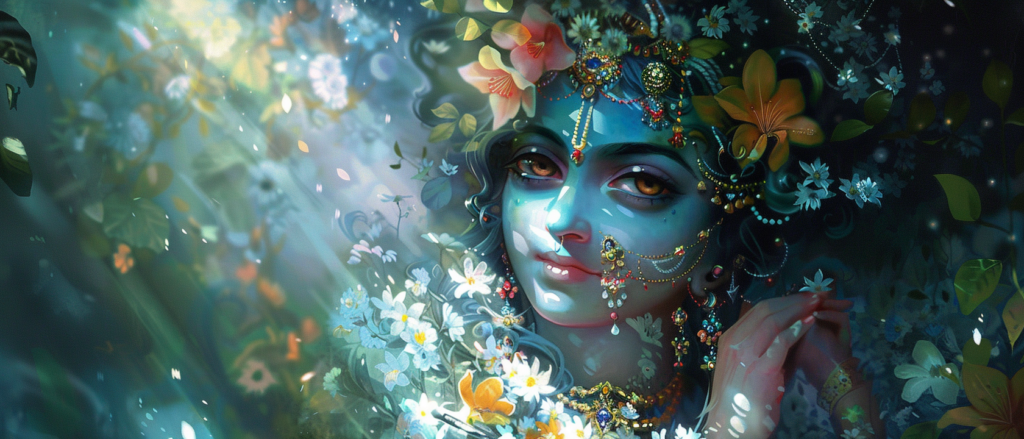
0 Comments